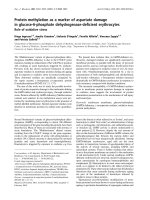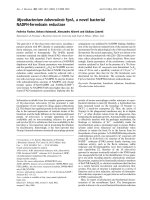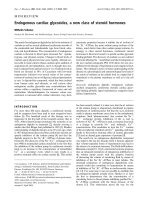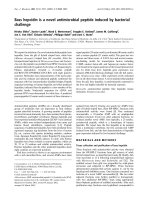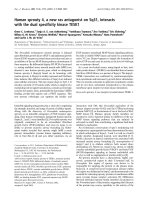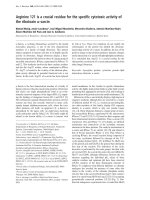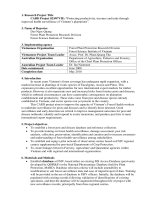Báo cáo y học: "WHO global campaigns: A way forward in addressing public health importance of common neurological disorders" ppt
Bạn đang xem bản rút gọn của tài liệu. Xem và tải ngay bản đầy đủ của tài liệu tại đây (175.86 KB, 2 trang )
BioMed Central
Page 1 of 2
(page number not for citation purposes)
Annals of General Hospital
Psychiatry
Open Access
Review
WHO global campaigns: A way forward in addressing public health
importance of common neurological disorders
Aleksandar Janca*
Address: School of Psychiatry and Clinical Neurosciences, University of Western Australia, Australia
Email: Aleksandar Janca* -
* Corresponding author
Fostering collaboration between scientific and profes-
sional groups that contribute to the advancement of glo-
bal public health is one of the main constitutional
responsibilities of the World Health Organization (WHO)
[1]. In line with this responsibility, WHO has organized
fifteen annual meetings with numerous non-governmen-
tal organizations (NGOs) concerned with prevention and
treatment of neurological disorders and created a unique
international forum for the exchange of knowledge and
information on public health aspects of neurological dis-
orders. These WHO/NGO annual gatherings have also
provided a useful platform for initiating international col-
laborative projects including two global campaigns on
neurological disorders, which mobilized health profes-
sionals, governments and general public in numerous
countries the world over [2].
The first large international collaborative activity on neu-
rological disorders carried out by WHO and NGOs was a
Global Initiative on Neurology and Public Health. This
joint project began in early 1990s aiming to draw atten-
tion of health professionals, health administrators and
general public to the frequency, severity and conse-
quences of common neurological disorders and to have
them acknowledged as public health problems by the
Ministries of Health of some 190 WHO Member States. In
order to achieve these objectives, the Global Initiative pro-
moted the existing possibilities for the prevention of neu-
rological disorders on a large-scale basis and emphasized
that neurological treatment and care should be provided
at all levels of health care and especially in primary care
settings, where a great majority of patients with neurolog-
ical disorders in different parts of the world receive their
treatment and care [2]. In the context of this Global Initi-
ative, WHO and NGOs jointly organized a series of sym-
posia at numerous international and national conferences
covering a plethora of public health aspects of neurologi-
cal disorders such as epidemiology; assessment of costs
and needs; organization of services; reduction of family
and community burden; education and training; research
on risk factors; and planing of programs and policies for
control of neurological disorders [3]. It is interesting to
note that this Global Initiative had no WHO or other
budget behind it and was mainly running on the enthusi-
asm of its coordinators and participants. Nevertheless, the
project achieved its objectives and served as a springboard
to another WHO/NGO global public health endeavor,
which came at the time of change in the leadership of
WHO.
The appointment of Dr Gro Harlem Brundtland as WHO
Director-General in 1998 brought a significant change to
the orientation of WHO programs and activities. Instead
of dealing simultaneously with a variety of global issues of
public health importance, the WHO units were asked to
prioritize ongoing projects and focus their activities on a
limited number of major public health problems includ-
ing serious and disabling disorders that clearly require
WHO action and where such an action can bring about a
global change in not too distant future [4,5]. Following
this new orientation and approach, the WHO Unit on
Neurological Disorders and Neuroscience decided to put
an emphasis on public health aspects of epilepsy, seeing it
as the most common serious neurological disorder and a
public health problem affecting all ages, races, social
classes and countries. In partnership with the Interna-
tional League Against Epilepsy (ILAE, a global profes-
sional NGO) and the International Bureau for Epilepsy
Published: 29 April 2004
Annals of General Hospital Psychiatry 2004, 3:9
Received: 14 April 2004
Accepted: 29 April 2004
This article is available from: />© 2004 Janca; licensee BioMed Central Ltd. This is an Open Access article: verbatim copying and redistribution of this article are permitted in all media for
any purpose, provided this notice is preserved along with the article's original URL.
Publish with BioMed Central and every
scientist can read your work free of charge
"BioMed Central will be the most significant development for
disseminating the results of biomedical research in our lifetime."
Sir Paul Nurse, Cancer Research UK
Your research papers will be:
available free of charge to the entire biomedical community
peer reviewed and published immediately upon acceptance
cited in PubMed and archived on PubMed Central
yours — you keep the copyright
Submit your manuscript here:
/>BioMedcentral
Annals of General Hospital Psychiatry 2004, 3 />Page 2 of 2
(page number not for citation purposes)
(IBE, a global lay NGO), WHO launched a Global Cam-
paign Against Epilepsy under a symbolic title "Out of the
Shadows". The rationale for this joint WHO/ILAE/IBE ini-
tiative has been based on the following public health
facts: (i) there are currently 50 million people with epi-
lepsy and the newly registered cases of epilepsy increase
this number by two million every year; (ii) 85% of people
with epilepsy live in developing countries and 90% of
them receive no diagnosis or treatment; (iii) epilepsy is
not difficult to diagnose if health personnel have received
minimum level of training and it can be effectively treated
with safe and inexpensive medications (e.g., in many
countries, the main antiepileptic drug phenobarbiton can
be produced and supplied for as little as $5 per person per
year); (iv) people with epilepsy are still viewed with fear,
suspicion and misunderstanding and are also subject to
horrendous stigma; and (v) epilepsy imposes enormous
physical, psychological, social and economic burdens on
individuals, families and communities all over the world
[5].
In order to address this grim public health picture, the
WHO/ILAE/IBE Global Campaign Against Epilepsy has
set the following objectives: (i) to increase public and pro-
fessional awareness of epilepsy as a universal and treata-
ble neurological disorder; (ii) to raise epilepsy on to a new
plane of acceptability in the public domain; (iii) to pro-
mote public and professional education about epilepsy;
(iv) to identify the needs of people with epilepsy on a
national and regional basis; (v) to encourage Govern-
ments and Departments of Health to address the needs of
people with epilepsy, including awareness, education,
diagnosis, treatment, care, services and prevention [6].
The First Phase of the Global Campaign was focused on
raising general awareness and understanding of epilepsy
and this was done through organization of several
regional conferences, which issued regional declarations
on epilepsy and involved about 50 developing and devel-
oped countries across Europe, Africa, South-East Asia and
North and South America. The Second Phase of the Glo-
bal Campaign is underway and is aiming to initiate and
implement a series of regional and national demonstra-
tion projects that would create models of good practice in
providing services to people with epilepsy worldwide.
In launching the Second Phase of the Global Campaign,
Dr Gro Harlem Brundtland, at that time the WHO Direc-
tor-General made the following statement: "The collabo-
ration between the International Bureau for Epilepsy, the
International League Against Epilepsy and WHO has
shown that when people with different backgrounds and
roles come together with a shared purpose, creativity is
released and expertise is used in innovative and construc-
tive ways" [7]. Indeed, it seems that WHO/NGO partner-
ship offers a model of successful international
collaboration in dealing with problems and disorders of
global public health importance. In May 2003, WHO got
a new Director-General (Dr Lee Jong-wook) and it
remains to be seen if and when will this so far impres-
sively successful example of WHO/NGO global partner-
ship be extended on to other common and disabling
neurological disorders and what mechanisms and criteria
will be used for their selection and prioritization.
References
1. World Health Organization: WHO- What it is, what it does.
Geneva, WHO; 1988.
2. World Health Organization: 14th meeting o NGOs concerned
with prevention and treatment of neurological disorders:
report. Geneva, WHO; 2002.
3. Janca A, Prilipko L, Costa e Silva JA: The World Health Organiza-
tion's global initiative on neurology and public health. J Neurol
Sci 1997, 145:1-2.
4. International Bureau for Epilepsy World Health Organization and
International League Against Epilepsy: Out of shadows. ILAE/IBE/
WHO global campaign against epilepsy. Cruquius: Paswerk
Bedrijven; 2000.
5. International Bureau for Epilepsy World Health Organization and
International League Against Epilepsy: Out of shadows. ILAE/IBE/
WHO global campaign against epilepsy. An introduction to
the global campaign and its demonstration projects. Cru-
quius. Paswerk Bedrijven; 2001.
6. Janca A, Prilipko L, Saraceno B: A World Health Organization
perspective on neurology and neuroscience. Arch Neurol 2000,
57:1786-1788.
7. World Health Organization International Bureau for Epilepsy Interna-
tional League Against Epilepsy: Global campaign against epilepsy.
Annual report for the ILAE/IBE/WHO Global Campaign
Against Epilepsy. Quart: Musemeci Industrie Grafiche; 2002.

